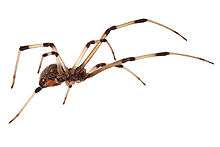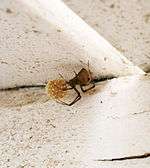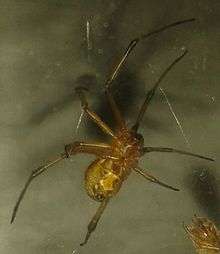Latrodectus geometricus
| Latrodectus geometricus | |
|---|---|
 | |
| Scientific classification | |
| Kingdom: | Animalia |
| Phylum: | Arthropoda |
| Subphylum: | Chelicerata |
| Class: | Arachnida |
| Order: | Araneae |
| Infraorder: | Araneomorphae |
| Family: | Theridiidae |
| Genus: | Latrodectus |
| Species: | L. geometricus |
| Binomial name | |
| Latrodectus geometricus Koch, 1841[1] | |
| Synonyms[1] | |
| |
Latrodectus geometricus, commonly known as the brown widow,[2][3] brown button, grey widow, brown black widow,[3] house button spider or geometric button spider, is one of the widow spiders in the genus Latrodectus. As such, it is a 'cousin' to the more infamous Latrodectus mactans (black widow).



Description
L. geometricus is slightly smaller[4] and generally lighter in color than the black widow species; the color can range from tan to dark brown to black, with shades of grey also possible. Like the black widow species in the United States, L. geometricus has a prominent hourglass-shaped marking on the underside of the abdomen; the brown widow's hourglass, however, is usually a vivid orange or a yellowish color. Unlike the black widow, L. geometricus has a black-and-white geometric pattern on the dorsal side of its abdomen. Although the Latin name comes from this pattern, a spider's coloring can and does darken over time and the pattern may become obscured. Also, they have stripes on their legs. Brown widows are often preyed on by mud daubers and sometimes by digger wasps.
Brown widows can be located by finding their egg sacs, which are easily identifiable. They resemble a sandspur, having pointed projections all over,[4] and they are sometimes described as "tufted", "fluffy",[4] or "spiky" in appearance. Eggs hatch in approximately 20 days.[5] Female brown widows "lay about 120-150 eggs per sac and can make 20 egg sacs over a lifetime."[2]
Similar widows include the L. rhodesiensis, a brown-colored relative of L. geometricus which is native to Zimbabwe. Both species are collectively known as brown button spiders throughout southern Africa. Brown button spiders are known to have a lifespan of about two years.[6]
Geographic distribution
The brown widow has a cosmopolitan distribution.[1] It is thought by some researchers to originate in South Africa,[3] although this is uncertain, as specimens were discovered in both Africa and South America.[2] They are usually found around buildings in tropical areas. They can compete with populations of the black widow spider.[7] It is found in many areas of South Africa, the United States,[2][3][4] Australia,[2] Afghanistan, China, Japan,[8] Dominican Republic,[9] Cyprus,[2] Costa Rica, El Salvador, and Brazil, and there have been sightings in the United Arab Emirates, Pakistan and Thailand.
As of 2012, researchers at the University of California, Riverside, suggested that the brown widow spider, newly established in Southern California, may in fact be displacing black widow spiders from the region, competing and/or fighting for territory.[10][11] While certainly not definitive, this evidence does suggest that the brown widow is likely to be more hostile and aggressive towards its relative, the black widow, than the black widow is towards it. If that proves to be true, humans may be positively affected because, over time, brown widows will aggressively eradicate and replace the black widows from the areas they inhabit, and since brown widows are less venomous than black widows, this may have the effect of making those areas safer.[11]
Toxicology
Like all Latrodectus species, L. geometricus has a neurotoxic venom that, drop for drop, is as toxic as the black widow's. The venom acts on nerve endings causing the very unpleasant symptoms of latrodectism. However, brown widow bites are usually not very dangerous; usually much less dangerous than the those of L mactans, the black widow.[7] The effects of the toxin are usually confined to the bite area and surrounding tissue, unlike the black widow's.[4] Mere toxicity of the venom is not the only factor in dangerousness. Brown widow bites are minor compared to black widow bites because they cannot deliver the same amount of venom as the black widow.[2] The LD50 of L. geometricus venom has been measured in mice as 0.43 mg/kg,[12] and separately again as 0.43 mg/kg (with a 95% confidence interval of 0.31-0.53).[13]
References
- 1 2 3 "Taxon details Latrodectus geometricus C.L. Koch, 1841". World Spider Catalog. Natural History Museum Bern. Retrieved 2016-10-29.
- 1 2 3 4 5 6 7 Vetter, Richard S. (2013). "The brown widow spider, Latrodectus geometricus". Department of Entomology, Center for Invasive Species Research, University of California, Riverside. Retrieved 15 July 2013.
- 1 2 3 4 Reagan, Mark (12 August 2011). "It's officially confirmed: There's a new spider in southwest Kansas". Dodge City Daily Globe. Archived from the original on 25 March 2012. Retrieved 28 September 2012.
- 1 2 3 4 5 Santana, Fred (2007). "Brown Widow Spiders". Sarasota County, Florida: Institute of Food and Agricultural Sciences, University of Florida. Retrieved 28 September 2012.
- ↑ Jackman, J A (2006). "Spiders", Texas Agricultural Extension Service.
- ↑ Murphy, Chris (4 March 2012). "Welcome to your nightmares: Meet the spider so tough it eats SNAKES for breakfast". Daily Mail. Retrieved 28 September 2012.
- 1 2 Brown, Eryn (2 July 2012). "Brown widow spiders 'taking over' in Southern California". Science Now. Los Angeles Times. Retrieved 28 September 2012.
- ↑ Ono, H (1995). "Records of Latrodectus geometricus (Araneae: Theridiidae) from Japan". Acta Arachnologica. 44 (2): 167–170. doi:10.2476/asjaa.44.167.
- ↑ "Hallan araña Viuda Marrón en Salinas de Baní" (in Spanish). El Nacional. 24 January 2012. Retrieved 8 October 2012.
- ↑ Are Brown Widow Spiders Displacing Black Widows? http://www.entsoc.org/press-releases/are-brown-widow-spiders-displacing-black-widows
- 1 2 Vetter, Richard S.; Vincent, Leonard S.; Danielsen, Douglas W.R.; Reinker, Kathryn I.; Clarke, Daniel E. (July 2012). "The Prevalence Of Brown Widow And Black Widow Spiders In Urban Southern California.". Journal of Medical Entomology. PMID 22897057.
- ↑ Rauber, Albert (1 January 1983). "Black Widow Spider Bites". Clinical Toxicology. 21 (4-5): 473–485. doi:10.3109/15563658308990435. PMID 6381753.
- ↑ McCrone, J.D. (1 December 1964). "Comparative lethality of several Latrodectus venoms". Toxicon. 2 (3): 201–203. doi:10.1016/0041-0101(64)90023-6.
External links
| Wikimedia Commons has media related to Latrodectus geometricus. |
| Wikispecies has information related to: Latrodectus geometricus |